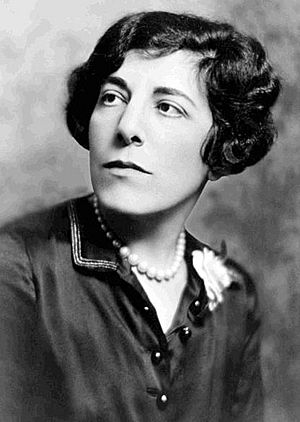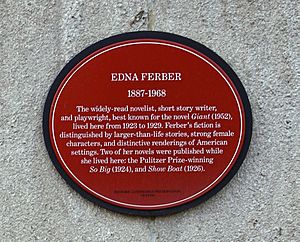Edna Ferber facts for kids
Quick facts for kids
Edna Ferber
|
|
|---|---|

Ferber in 1928
|
|
| Born | August 15, 1885 Kalamazoo, Michigan, U.S. |
| Died | April 16, 1968 (aged 82) New York City, U.S. |
| Occupation | Novelist, playwright |
| Genre | Drama, romance |
| Notable awards | Pulitzer Prize for Fiction (1925) |
Edna Ferber (born August 15, 1885 – died April 16, 1968) was a famous American writer. She wrote many novels, short stories, and plays. Some of her most well-known books include So Big (which won a Pulitzer Prize), Show Boat, Cimarron, and Giant. Many of her books were turned into popular movies and musicals.
Life and Career
Growing Up
Edna Ferber was born on August 15, 1885, in Kalamazoo, Michigan. Her father, Jacob, was a Jewish store owner from Hungary. Her mother, Julia, was from Milwaukee, Wisconsin. Edna had an older sister named Fannie.
Edna's family moved around a lot when she was a child. Her father had trouble with his business. They lived in Chicago, Illinois, and then in Ottumwa, Iowa for seven years. In Ottumwa, Edna faced unkindness because her family was Jewish. This experience made her feel a bit tough towards the world.
When Edna was 12, her family moved to Appleton, Wisconsin. She finished high school there. She also went to Lawrence University for a short time.
Starting Her Writing Career
After high school, Edna wanted to become an actor. But her family could not afford college for her. So, she took a job as a young reporter at a local newspaper. Later, she worked for a bigger newspaper in Milwaukee.
In 1909, Edna became sick and went back home to Appleton to get better. She stopped being a reporter. But she did cover some big political events later on. While recovering, she started writing short stories. She sold them to different magazines.
Her first novel, Dawn O'Hara, The Girl Who Laughed, came out in 1911. A collection of her short stories was published in 1912. It was called Buttered Side Down.
Famous Books and Awards
In 1925, Edna Ferber won the important Pulitzer Prize for her novel So Big. She was surprised because she thought the book might not be popular. But it sold hundreds of thousands of copies! So Big was made into a silent film the same year. Later, it was made into movies again in 1932 and 1953. The 1953 version is still very popular today.
Her next novel, Show Boat, was also a huge success. A composer named Jerome Kern wanted to turn it into a musical. Edna was worried it would be a silly show. But Kern and Oscar Hammerstein II wanted to make a new kind of musical. Edna agreed, and the musical opened on Broadway in 1927. It has been performed many times since then.
Another one of her famous novels, Giant, came out in 1952. It was made into a very popular movie in 1956. That movie starred famous actors like Elizabeth Taylor, James Dean, and Rock Hudson.
Later Life and Death
Edna Ferber passed away at her home in New York City in 1968. She was 82 years old.
Personal Life
Edna Ferber was known for being very direct and witty. She once led other Jewish guests out of a party when she found out the host was unkind to Jewish people. She also had a quick comeback when someone made a joke about her clothes.
Her Jewish Identity
Starting in 1922, Edna Ferber traveled to Europe often. During these trips, she became very worried about the rise of the Nazi Party. She saw how anti-Jewish feelings were spreading, just like what she had experienced as a child. She said it was scary to see a whole civilization "crumbling."
Her fears about this unfairness greatly influenced her writing. Her books often explored themes of unfair treatment based on someone's background or culture. She wanted to show how Jewish people could succeed and overcome challenges.
The Algonquin Round Table
Edna Ferber was part of a famous group called the Algonquin Round Table. This was a group of smart and witty writers, critics, and actors. They met for lunch every day at the Algonquin Hotel in New York City.
Edna worked with another member of the group, George S. Kaufman, on several plays. These plays were shown on Broadway. Some of their plays include Minick (1924), The Royal Family (1927), and Dinner at Eight (1932).
Her Views
In 1940, a magazine asked American writers who they supported for president. Edna Ferber was one of the writers who supported Franklin D. Roosevelt.
What Her Books Are Like
Edna Ferber's novels often featured strong female main characters. They also had many interesting supporting characters. She often highlighted characters who faced unfair treatment because of their background.
Her stories often explored different parts of American culture. Sometimes, her books were set in places she had visited, like Texas or Alaska. She helped show readers the amazing variety of American life.
Her Legacy
Edna Ferber's work continues to be remembered.
- An actress named Lili Taylor played Edna Ferber in a movie called Mrs. Parker and the Vicious Circle (1994).
- In 2002, the U.S. Postal Service made a postage stamp honoring her.
- In her hometown of Appleton, Wisconsin, an elementary school is named after her.
- In 2013, Edna Ferber was added to the Chicago Literary Hall of Fame.
List of Works
Edna Ferber wrote many novels, short stories, and plays. She also wrote two books about her own life.
Novels
- Dawn O'Hara, The Girl Who Laughed (1911)
- Fanny Herself (1917)
- The Girls (1921)
- So Big (1924) (won Pulitzer Prize)
- Show Boat (1926)
- Cimarron (1930)
- American Beauty (1931)
- Come and Get It (1935)
- Saratoga Trunk (1941)
- Great Son (1945)
- Giant (1952)
- Ice Palace (1958)
Short Story Collections
- Buttered Side Down (1912)
- Roast Beef, Medium (1913)
- Personality Plus (1914)
- Emma Mc Chesney and Co. (1915)
- Cheerful – By Request (1918)
- Half Portions (1919)
- Mother Knows Best (1927)
- They Brought Their Women (1933)
- Nobody's in Town: Two Short Novels (1938)
- One Basket: Thirty-One Short Stories (1947)
Autobiographies (Books About Her Own Life)
- A Peculiar Treasure (1939)
- A Kind of Magic (1963)
Plays
- Our Mrs. McChesney (1915) (with George V. Hobart)
- $1200 a Year: A Comedy in Three Acts (1920) (with Newman Levy)
- Minick: A Play (1924) (with G. S. Kaufman)
- The Royal Family (1927) (with G. S. Kaufman)
- Dinner at Eight (1932) (with G. S. Kaufman)
- Stage Door (1936) (with G.S. Kaufman)
- The Land Is Bright (1941) (with G. S. Kaufman)
- Bravo (1949) (with G. S. Kaufman)
Screenplays (Movies She Wrote)
- Saratoga Trunk (1945) (with Casey Robinson)
Musical Adaptations (Musicals Based on Her Work)
- Show Boat (1927)
- Saratoga (1959)
- Giant (2009)
See also
 In Spanish: Edna Ferber para niños
In Spanish: Edna Ferber para niños


